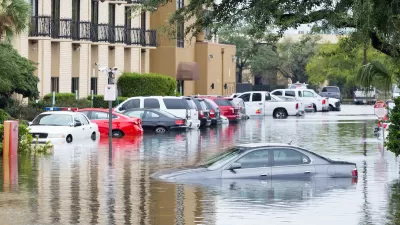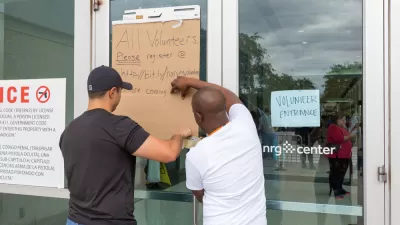From wildfires to hurricanes, environmental risks pose a threat to around 40 percent of U.S. rental units.

More than 17 million rental units across the United States are at risk of "substantial annual losses" from environmental hazards, warns the Joint Center for Housing Studies' American Rental Housing 2022 report. According to Sophia Wedeen, who outlines the report's findings, this represents about 40 percent of total occupied rental units in the country.
"Areas with substantial expected annual losses are geographically widespread, reflecting the variety of acute and chronic environmental hazards that impact every part of the country." While California and the West Coast face high wildfire risks, Gulf Coast states are threatened by hurricanes and flooding. "California has the largest number of rental units at risk, with 4.5 million rentals (76 percent of the state’s occupied rental stock) located in census tracts with at least moderate expected annual losses due to likely hazards."
Wedeen notes that renters in manufactured homes are at especially high risk. "Manufactured units are also more likely to be classified as structurally inadequate by HUD than other types of rental units, and therefore may be especially vulnerable to loss due to hazards."
As the effects of climate change worsen, some rental units will become uninhabitable, requiring a "massive federal and local investment" to preserve and adapt existing stock, says the report. "In the short term, damage from hazards will almost certainly drive up the cost of repairing and rebuilding rental units. Reducing the time to build replacement rental housing after a natural disaster and increasing the availability of post-disaster financial assistance for renters are both urgent priorities."
FULL STORY: THE THREAT OF ENVIRONMENTAL HAZARDS TO THE RENTAL STOCK

Alabama: Trump Terminates Settlements for Black Communities Harmed By Raw Sewage
Trump deemed the landmark civil rights agreement “illegal DEI and environmental justice policy.”

Study: Maui’s Plan to Convert Vacation Rentals to Long-Term Housing Could Cause Nearly $1 Billion Economic Loss
The plan would reduce visitor accommodation by 25% resulting in 1,900 jobs lost.

Why Should We Subsidize Public Transportation?
Many public transit agencies face financial stress due to rising costs, declining fare revenue, and declining subsidies. Transit advocates must provide a strong business case for increasing public transit funding.

Paris Bike Boom Leads to Steep Drop in Air Pollution
The French city’s air quality has improved dramatically in the past 20 years, coinciding with a growth in cycling.

Why Housing Costs More to Build in California Than in Texas
Hard costs like labor and materials combined with ‘soft’ costs such as permitting make building in the San Francisco Bay Area almost three times as costly as in Texas cities.

San Diego County Sees a Rise in Urban Coyotes
San Diego County experiences a rise in urban coyotes, as sightings become prevalent throughout its urban neighbourhoods and surrounding areas.
Urban Design for Planners 1: Software Tools
This six-course series explores essential urban design concepts using open source software and equips planners with the tools they need to participate fully in the urban design process.
Planning for Universal Design
Learn the tools for implementing Universal Design in planning regulations.
Smith Gee Studio
Alamo Area Metropolitan Planning Organization
City of Santa Clarita
Institute for Housing and Urban Development Studies (IHS)
City of Grandview
Harvard GSD Executive Education
Toledo-Lucas County Plan Commissions
Salt Lake City
NYU Wagner Graduate School of Public Service





























